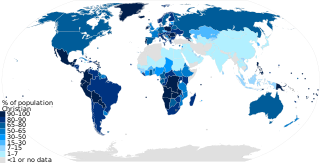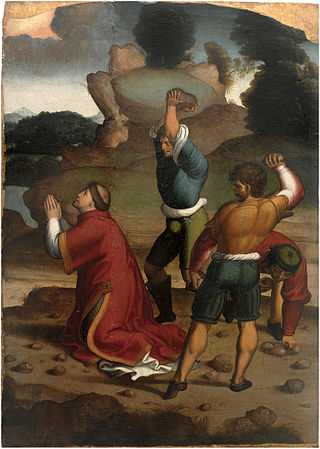
Christianity, less commonly referred to as Christianism, is an Abrahamic monotheistic religion based on the life and teachings of Jesus of Nazareth. It is the world's largest and most widespread religion with roughly 2.4 billion followers representing one-third of the global population. Its adherents, known as Christians, are estimated to make up a majority of the population in 157 countries and territories, and believe that Jesus is the Son of God, whose coming as the Messiah was prophesied in the Hebrew Bible and chronicled in the New Testament.

Christendom historically refers to the Christian states, Christian empires, Christian-majority countries and the countries in which Christianity dominates, prevails, or that it is culturally or historically intertwined with.

The history of Christianity concerns the Christian religion, Christian countries, and the Christians with their various denominations, from the 1st century to the present. Christianity originated with the ministry of Jesus, a Jewish teacher and healer who proclaimed the imminent Kingdom of God and was crucified c. AD 30–33 in Jerusalem in the Roman province of Judea. His followers believe that, according to the Gospels, he was the Son of God and that he died for the forgiveness of sins and was raised from the dead and exalted by God, and will return soon at the inception of God's kingdom.

The Great Apostasy is a concept within Christianity to describe a perception that mainstream Christian Churches have fallen away from the original faith founded by Jesus and promulgated through his twelve Apostles.

Donatism was a Christian sect leading to a schism in the Church, in the region of the Church of Carthage, from the fourth to the sixth centuries. Donatists argued that Christian clergy must be faultless for their ministry to be effective and their prayers and sacraments to be valid. Donatism had its roots in the long-established Christian community of the Roman province Africa Proconsularis, in the persecutions of Christians under Diocletian. Named after the Berber Christian bishop Donatus Magnus, Donatism flourished during the fourth and fifth centuries.

"Jesus is Lord" is the shortest credal affirmation found in the New Testament, one of several slightly more elaborate variations. It serves as a statement of faith for the majority of Christians who regard Jesus as both fully man and God. It is the motto of the World Council of Churches.

In Christianity, a martyr is a person considered to have died because of their testimony for Jesus or faith in Jesus. In years of the early church, stories depict this often occurring through death by sawing, stoning, crucifixion, burning at the stake or other forms of torture and capital punishment. The word martyr comes from the Koine word μάρτυς, mártys, which means "witness" or "testimony".

The Diocletianic or Great Persecution was the last and most severe persecution of Christians in the Roman Empire. In 303, the emperors Diocletian, Maximian, Galerius, and Constantius issued a series of edicts rescinding Christians' legal rights and demanding that they comply with traditional religious practices. Later edicts targeted the clergy and demanded universal sacrifice, ordering all inhabitants to sacrifice to the gods. The persecution varied in intensity across the empire—weakest in Gaul and Britain, where only the first edict was applied, and strongest in the Eastern provinces. Persecutory laws were nullified by different emperors at different times, but Constantine and Licinius' Edict of Milan in 313 has traditionally marked the end of the persecution.
William Hugh Clifford Frend was an English ecclesiastical historian, archaeologist, and Anglican priest.

The doctrine of the Trinity, considered the core of Christian theology by Trinitarians, is the result of continuous exploration by the church of the biblical data, thrashed out in debate and treatises, eventually formulated at the First Council of Nicaea in AD 325 in a way they believe is consistent with the biblical witness, and further refined in later councils and writings. The most widely recognized Biblical foundations for the doctrine's formulation are in the Gospel of John, which possess ideas that originate in Platonism and Greek philosophy.
The persecution of Christians in the New Testament is an important part of the Early Christian narrative which depicts the early Church as being persecuted for their heterodox beliefs by a Jewish establishment in what was then the Roman province of Judea.

Christianity began as a Second Temple Judaic sect in the 1st century in the Roman province of Judea, from where it spread throughout and beyond the Roman Empire.

Christianity in the ante-Nicene period was the time in Christian history up to the First Council of Nicaea. This article covers the period following the Apostolic Age of the first century, c. 100 AD, to Nicaea in 325 AD.

Christianity in the 1st century covers the formative history of Christianity from the start of the ministry of Jesus to the death of the last of the Twelve Apostles and is thus also known as the Apostolic Age. Early Christianity developed out of the eschatological ministry of Jesus. Subsequent to Jesus' death, his earliest followers formed an apocalyptic messianic Jewish sect during the late Second Temple period of the 1st century. Initially believing that Jesus' resurrection was the start of the end time, their beliefs soon changed in the expected Second Coming of Jesus and the start of God's Kingdom at a later point in time.

The following outline is provided as an overview of and topical guide to Christianity:

Early Christianity, up to the First Council of Nicaea in 325, spread from the Levant, across the Roman Empire, and beyond. Originally, this progression was closely connected to already established Jewish centers in the Holy Land and the Jewish diaspora. The first followers of Christianity were Jews who had converted to the faith, i.e. Jewish Christians.

Christianity in late antiquity traces Christianity during the Christian Roman Empire – the period from the rise of Christianity under Emperor Constantine, until the fall of the Western Roman Empire. The end-date of this period varies because the transition to the sub-Roman period occurred gradually and at different times in different areas. One may generally date late ancient Christianity as lasting to the late 6th century and the re-conquests under Justinian of the Byzantine Empire, though a more traditional end-date is 476, the year in which Odoacer deposed Romulus Augustus, traditionally considered the last western emperor.

In the history of the Roman Empire, the "Little Peace of the Church" was a roughly 40-year period in the latter 3rd century when Christianity flourished without official suppression from the central government. It is particularly associated with the reign of Gallienus (253–268), who issued the first official declaration of tolerance regarding Christians. Among the series of imperial edicts that halted acts of persecution against Christians, one addressed to the bishops of Egypt has survived, recognizing places of worship and cemeteries as ecclesiastical property and restoring them to Christian ownership. The Church for the first time even asked a Roman emperor to arbitrate an internal dispute. In 272, after Paul of Samosata was accused of heresy but refused to be deposed as bishop of Antioch, Aurelian ruled in favor of his successor, who was in good standing with the church hierarchy.

A History of Christianity: The First Three Thousand Years is a 2009 book written by the English ecclesiastical historian Diarmaid MacCulloch, Professor of the History of the Church at the University of Oxford. It is a survey of the historical development of the Christian religion since its inception in the 1st century to the contemporary era. The first American edition was titled Christianity: The First Three Thousand Years, published in 2010 by Viking Press, imprint of Penguin Books.
Christian devotional literature is religious writing that Christian individuals read for their personal growth and spiritual formation. Such literature often takes the form of Christian daily devotionals. Original excerpts including the Book of Daniel and Leviticus derive from Ancient Roman, Greek and Byzantine culture – and encompass the past relationship of God's Law through the Old Testament. Though these are the most significant accounts, the majority of the literature comprises commentaries to the ever changing social and political reforms of human history – including the impact of censorship, persecution – the reign of Emperor Nero and Diocletian and martyrdom on Christian life through the ages.















